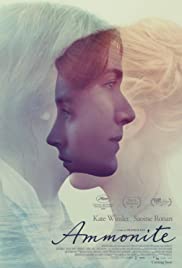
AMMONITE
UK, 2020, 117 minutes, Colour.
Kate Winslet, Saoirse Ronan, Gemma Jones, Fiona Shaw, James Mc Ardle, Alec Secareanu, Claire Rushbrook.
Directed by Francis Lee.
Many, non-scientific audiences, will be wanting to check out the name first. So, here is one description: :
“From ammonite, the fossils of an extinct cephalopod with a spiral shell like a ram's horn. Ammonite was named after the Ancient Egyptian god Amun, who was represented with ram's horns.� For a more technical description see below.
This film is something of a portrait, of a middle-aged, unmarried geologist, living and working in Lyme Regis, skilled in scouring the beaches and cliffs for stones and rocks which may contain the remnants of extinct creatures. Her name was Mary Anning. She had made discoveries but, in the atmosphere of the mid 19th century, her work was exhibited in the British Museum but overlooked because of her gender.
Kate Winslet gives a powerful performance, at times inexpressive, seemingly attached, silent, yet a steely determination inside as well as strong emotional needs. Mary Anning lives at home, running a souvenir shop for tourists with her mother, Gemma Jones.
She is visited by a would-be researcher-scientist, Roderick Murchison (James Mc Ardle). He praises Mary’s overlooked researches and asks to observe and work with her for a day on the beach. Accompanying him is his fragile wife, Charlotte, played by Saoirse Ronan who has to range in her performance from depressed to finally exhilarated.
Murchison pays Mary to care for his wife while he is away, urging her to accompany her on her research. Mary is reluctant, but when Charlotte contracts a fever, she tends to her with diligence and care, praised by the doctor (Alec Secereanu) who invites Mary to a musical recital. Charlotte accompanies her and meets the local apothecary, Elizabeth Philpott (Fiona Shaw). When Mary visits Elizabeth, there are suggestions of past intimacy.
And intimacy is what develops between Mary and Charlotte, Mary becoming less restrained, Charlotte discovering affection that she did not find from her husband. The relationship develops and there are some intense intimate scenes between them.
While Charlotte comes alive again, Mary returns to her way of life, saddened by the death of her mother.
Some have complained that the film is very slow – which, in a way, is a compliment to its writer-director, Francis Lee, who intends it to be a portrait of people, a portrait of a way of life, a portrait of the developing of a relationship which takes its time and is to be contemplated. (Lee directed God’s Own Country, a story of a relationship between two farmers – and uses two of its actors, Gemma Jones and Alec Secereanu as Mary’s mother and the doctor.)
A more detailed definition: Ammonoid, also called ammonite, any of a group of extinct cephalopods (of the phylum Mollusca), forms related to the modern pearly nautilus (Nautilus), that are frequently found as fossils in marine rocks dating from the Devonian Period (began 419 million years ago) to the Cretaceous Period (ended 66 million years ago) ...
1. The title? The need for knowledge before the film? Information provided during the film?
2. The background of geology, scientific research in the 19th century, the role of men, contribution of women, women overlooked, exhibitions and the British Museum?
3. The period, costumes and decor, lighting, carriages and horses, M Regis, the shop, interiors, harsh conditions, the streets, the social gatherings for the upper-class, music? The beach on the cliffs? The sea and its moods? The musical score?
4. A portrait of Mary Ann Ing? Kate Winslet’s performance and presence? Age, her family background, the deaths of her siblings, living with her mother, her mother’s age and illness? The souvenir shop? A research on the beach, the stones, the cliffs, discoveries? Her painstaking and detailed work at home?
5. The visit of Roderick Murchison, wealth, scientist, praising Mary, wanting to accompany her on the beach, the payment, his experience? His going away on research? His relationship with his wife, not wanting children at this stage? The effect of his absence?
6. Charlotte, quiet, depressed, with her husband, their sexual relationship, difficulties? His departure, her leaving the hotel, going to stay with Mary, her husband’s payments? Accompanying Mary, Mary’s reluctance, on the beach, in the carriage going into the water, her fever, the visit of the doctor, Mary having to care for her, Mary’s mother’s objections, the doctor’s advice, going to see Elizabeth Philpott and getting the medication? Charlotte’s recovery?
7. Mary and the visit to Elizabeth, the suggestions of past intimacy and hurt? Elizabeth behaviour with Charlotte of the music recital? Mary’s reaction, leaving? Elizabeth visiting Mary at the end, apologising for past hurt? The lasting effect of Elizabeth’s influence on Mary?
8. Charlotte reviving, accompanying Mary, the brighter clothes, cheerful, on the beach, the large rock, pulling it out, scraping, the discovery?
9. The growing friendship between Charlotte and Mary, the sexual intimations, kissing and embrace, the consequences, the relationship, the sexual experience? The effect on each?
10. Roderick’s return, Charlotte going back to London, the Farewell? Mary returning to her quiet way of life? Her mother’s collapse and death, the funeral?
11. Mary, resuming her life, the visit of Elizabeth and its consequences? Charlotte invitation, the boat ride, going to London, shallots preparation for living with her, the room and all the comforts? Mary’s reaction? Wanting other lodgings? Charlotte’s shock?
12. Mary going to the British Museum, the false attribution on her exhibit? Charlotte arriving – and the final scene with two standing by the exhibit, facing each other, the audience supplying what would happen in the future?